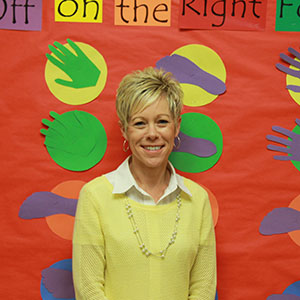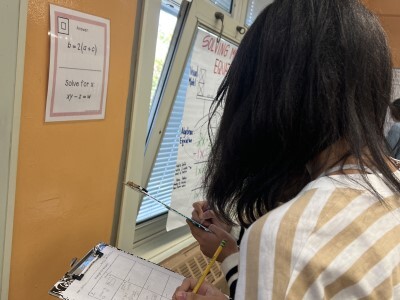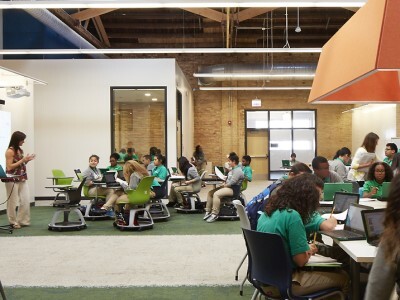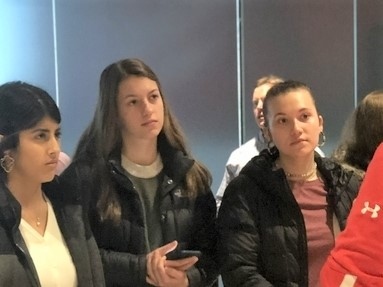How Self-Paced Learning Builds Movement and Collaboration
Topics
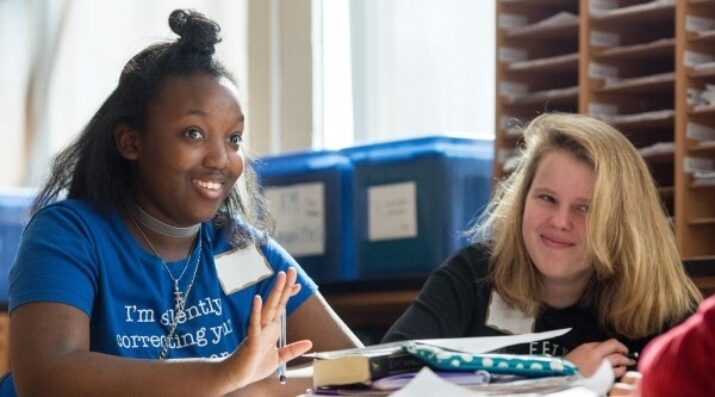
We’ve all had the experience of truly purposeful, authentic learning and know how valuable it is. Educators are taking the best of what we know about learning, student support, effective instruction, and interpersonal skill-building to completely reimagine schools so that students experience that kind of purposeful learning all day, every day.
When middle school students can move around to take mental breaks and collaborate with their peers, they can achieve more and do more rigorous work.
As a veteran teacher and mother of three sons including twins, I have learned to embrace the need for middle school students to be social and have found ways to successfully build in time to move, take breaks, and collaborate. Because my seventh and eighth grade English/language arts (ELA) students self-pace for 30-45 minutes of our 90-minute block, they appreciate these routines. The result is my students are achieving more and doing more rigorous tasks. It is a win-win for all!
Because I am a Modern Classrooms Project Distinguished Educator, I have learned how to structure self-pacing for part of the ELA block. The first task in my self-pacing classroom is for students to watch a short instructional video which has allowed me to clone myself. Movement is built into my video lessons. As students watch the video, I tell them to pause at a certain point to write an answer on the board to show everyone their thinking. It can be a question to get them to think, debate, predict, etc. This provides an anchor for those students who need others to model first. It also allows me to see their understanding right at the start of a new lesson. I can then meet with students one-on-one to clear up any misconceptions. In some of my videos, I tell them to pause and do something just for the sake of moving such as standing up and doing five jumping jacks or walking up to me and giving me a high five. They enjoy these off-the-wall requests!
It happened organically because they felt safe to get up and seek out others to have rigorous academic conversations.
Building in short commercial breaks is also key to keep momentum. Within self-pacing time, students can take a five minute “coffee” break which could include walking down the hall and back, drawing, listening to music, etc. If the vibe of the room indicates to me that they all need a break, then I will interject spontaneous dance parties, Simon Says, Look Up/Look Down, four corner trivia questions, and other movement games. I set the timer for five minutes, and when the break is over, they all get back to work quickly.
Collaboration is highly encouraged during self-pacing time. This might be a required task such as a review game with a classmate or just time to seek out a thinking partner. Because we discuss and model what this looks like at the start of a school year, my students become proficient working together. We establish rules and consequences the first week of school. As students work through a lesson, they seek out others that are on the same task. Recently I witnessed a small group of seventh grade boys debating a question after reading President Teddy Roosevelt’s, “The Man in the Arena.” It was beautiful! And it happened organically because they felt safe to get up and seek out others to have rigorous academic conversations. This rocks my world!
My advice for productive collaboration is to embrace it when it falls apart. For example, I was working with a small group when another group of three students got off task. I could hear them discussing the basketball game from the night before. I wrapped up with my group, and then called the class to attention. We simply had a conversation about what to do to remain on task. The off-task group said they got stuck. We discussed how sometimes the lesson is very difficult, and it is okay to just need a break. By spending less than ten minutes regrouping, we worked together to find solutions. They appreciated not being scolded for being off task. It was a chance to build their trust in me because they felt heard.
Finally, a very simple way to allow a break is to compliment students on their hard work and efforts and give them the last few minutes of class to move around and talk. I only recently saw the benefits of this as I had always wanted to get every second possible out of academic time. This happens more frequently on Fridays after I applaud the learning that occurred during the week.
After reflecting on how much class time was spent sitting still vs. moving, I realized that more opportunities were needed to move which led to more collaboration. The benefits have been evident as we have moved more quickly through the curriculum. I owe this success to the Modern Classroom Project which sent me on my journey of finding answers I had been searching for 24 years! Using the MCP model, self-paced lessons have allowed for better differentiation, rapport building, independent learning—and more movement!. My students and I are much happier as a result!
Photo at top by Allison Shelley/The Verbatim Agency for EDUimages, CC BY-NC 4.0

